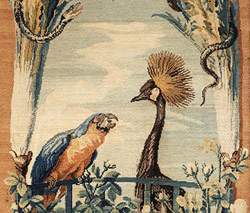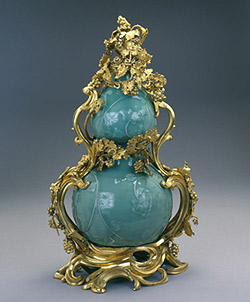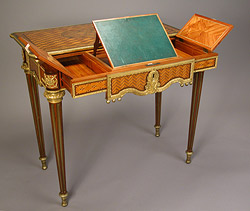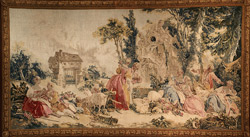 |
 |
|
 |
 |


 |
 |
Six-Panel Folding Screen (detail),
Savonnerie Manufactory, 1719–1784
The Huntington Library, Art Collections,
and Botanical Gardens, San Marino |
|
Railroad tycoon Henry E. Huntington (1850–1927) and oil magnate J. Paul Getty (1892–1976)
shared a passion for French art, especially 18th-century French decorative arts. Parts of the collections
they assembled have now come together in a unique crosstown collaboration featuring 17 beautiful
objects—including tapestries, furniture, sculpture, and vases—from the Huntington Library,
Art Collections, and Botanical Gardens in San Marino. The objects, which were carefully selected for
their connections with specific pieces from the J. Paul Getty Museum, are on view at the Getty Center through
Sunday, November 4, 2007, while the Huntington Gallery, the Huntingtons' original mansion, is renovated.
|
 |

 |
 |
Vase, Chinese and French, 1300–1350 (vase) and 1745–1749 (gilt-bronze mounts)
The Huntington Library, Art Collections, and Botanical Gardens, San Marino |
|
 |
The objects in the Huntington loan reflect a range of styles—Baroque, Rococo, and Neoclassical—and influences, including chinoiserie, a fascination with artistic forms and techniques from the Middle and Far East.
Between 1745 and 1749, French craftsmen fitted this antique celadon vase with gilt-bronze mounts composed of elaborate scrollwork intertwined with vine leaves, tendrils, and grapes that echo the peony relief on the porcelain. This vase was already four centuries old when it was mounted, making it a particularly rare and beautiful example of chinoiserie.
The vase sits atop a French commode from the Museum's collection that is veneered with panels of Japanese lacquer, another luxury material whose popularity illustrates the 18th-century French fascination with the Orient.
|
 |
 |


 |
 |
Writing Table, Bernard Molitor, 1788–1796
The Huntington Library, Art Collections, and Botanical Gardens, San Marino |
 |
Many of the objects in the installation were prized for their usefulness as well as their beauty. A luxurious six-panel folding screen upholstered with knotted wool scenes of exotic animals (see detail at the top of this page) served as a fashionable means of protection against drafts in the large, poorly heated rooms of the mid-1700s. The owners of this compact table by Bernard Molitor would have used it not only for writing, but also to demonstrate their elegance and superior taste. The drawer is fitted with movable elements, including a liftable writing panel, while the top is ornamented with illusionistic marquetry depicting a half-opened Japanese box containing a shell. Compare this delicate piece to Molitor's massive rolltop desk in the next gallery to see the stylistic extremes found within a single furniture workshop in 18th-century France.
|
 |

 |
 |
The Fountain of Love, Beauvais Manufactory, 1757–1760
The Huntington Library, Art Collections, and Botanical Gardens, San Marino |
|
 |
A highlight of the installation is a group of three tapestries designed by
François Boucher,
a master of the light and colorful Rococo style who was as influential for his
theater and tapestry designs as for his paintings. The Fountain of Love,
The Fishermaid, and The Luncheon come from his Noble Pastoral
series of the 1750s, which features idyllic country scenes that appealed to the upper
classes of pre-revolutionary France. Made of wool and silk, tapestries were prized as
wall coverings in the 1600s and 1700s both for insulation and for decoration.
This tapestry series after Boucher was so popular that the French Crown ordered as
many as five sets, three of which were presented as important diplomatic gifts. Parisian
collectors also eagerly sought Boucher's tapestries, which cost many times the price of
his paintings.
|
 |
|
Near the tapestries hangs Boucher's oil study for The Fountain of Love from the Getty Museum's permanent collection. This full-scale preparatory painted design for the tapestry, known as a cartoon, features an elaborate fountain surrounded by young, amorous couples dressed in shepherds' costumes. The bright colors of the painting suggest how vivid the tapestry must have been when it was first made.
Weavers at the Beauvais Manufactory cut the cartoon into thin vertical pieces and placed them under the strings of their loom to guide their weaving. The surviving strips were later joined back together into the painting you see today, although the seams are still visible at close range.
Designs by Boucher appear in other objects from the Huntington loan as well, including a pair of lidded vases from the Sèvres porcelain manufactory. You will find them and the other Huntington loans at the J. Paul Getty Museum at the Getty Center in the South Pavilion through 2007. Look for "The Huntington Loan" on the labels throughout.
|
 |
|
 |
|